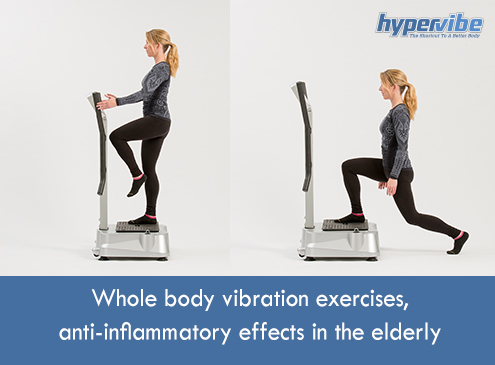
Aging and inflammation are linked, this natural process resulting in low-grade inflammation that is not disabling in itself, but can make one more prone to disease, and impair their physical functioning. Environmental and lifestyle factors may contribute to age-related inflammation, but regular exercise may act as a natural anti-inflammatory solution.
Although exercise may also be responsible for a temporary increase in inflammatory markers, studies have shown that high intensity workouts can combat inflammation. Long-term aerobic programs were also proven to decrease systemic inflammation and improve the metabolic function.
All forms of physical activity have anti-inflammatory effects, and whole body vibration exercises are just another form of workout, but it’s still great to see that there are studies that confirm the positive effects of WBV on one’s health.
Published in the journal of Mechanisms of ageing and development, the first study we’ll refer to was conducted by scientists from the Georgia Regents University, USA, and involved the participation of 28 elderly patients. The subjects were randomly assigned to either a training or a control group, and followed a 8-week whole body vibration program. Blood samples were taken before and after the workouts, and after the 8 weeks, results showed that this form of training may improve the anti-inflammatory status of the subjects.
According to this study, whole body vibration may reduce the plasma concentration of C-reactive protein. This protein is produced by the liver, a rise in its level indicating that there’s inflammation throughout the body. A recent infection or long-term inflammation may lead to an increased production of C-reactive protein.
Poor sleep quality or sleep deprivation may raise inflammation, which in turn leads to a greater risk of stroke and heart disease. The daily stress, sedentary lifestyle and poor diet choices make us more prone to inflammation. This process can operate in stealth mode for months and years, and finally start manifesting through disturbing symptoms when the damage is already done. Diabetes type 2, osteoarthritis, Alzheimer’s, celiac disease, lupus and psoriasis are only some examples of inflammation-related diseases.
However, inflammation in itself is not a negative process. In fact, it’s the body’s way of dealing with an injury or trauma: if you accidentally cut your finger, the body sends white cells to the site of injury, and these white cells start destroying the harmful bacteria, helping the body heal. Soreness, swelling and heat are some of the physical signs of inflammation that show that your organism is managing the injury in a healthy and efficient way. This is the ideal case though, and applies to acute inflammation only.
Acute inflammation has a rapid onset and becomes severe quickly, but the signs are only present for a couple of days or weeks. Some examples are acute appendicitis, sinusitis, bronchitis, or a sore throat. All these are treatable and in most cases don’t threaten one’s life and don’t affect their health in an irreversible manner.
Chronic inflammation on the other hand is persists for long term and can lead to the previously mentioned ailments. This form of inflammation appears when the acute inflammation can’t be efficiently treated, or when the body exerts a powerful autoimmune response to a self antigen, meaning that it attacks its own, healthy cells, after mistaking them for pathogens.
Acute inflammation gets better within days or develops into chronic inflammation, which can lead to the destruction of cells and their death (necrosis) or to the thickening and scarring of tissue (fibrosis).
Although medications can be used for reducing inflammation in its incipient stages and preventing it from becoming chronic, lifestyle changes like eating more anti-inflammatory foods, getting more rest or losing weight and staying active can have a similar effect. Studies have shown that overweight people have more inflammatory markers and that losing 5% of the body weight can lead to significant falls in levels of inflammation markers.
Thus, if you want to reduce your risk of age-related inflammation and stay healthy for longer, try adding exercise to your daily routine. If you’re not into classical workouts or aerobic exercises, whole body vibration machine may be a solution too!
Have something to add to this article? Comment below or join our Facebook community and share your thoughts with us!

Updated on: 08.09.2021 The lymphatic system is involved not only...

Stress can make you gain weight – we’ve heard this...

Various theories exist to answer this question. As you will...

Both rebounding and jumping on a trampoline are excellent ways...

The health benefits of using vibration plates to burn fat...